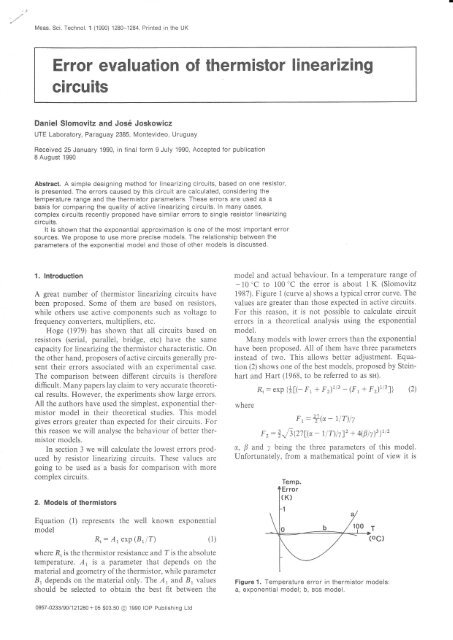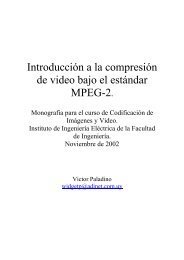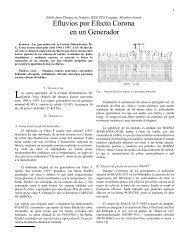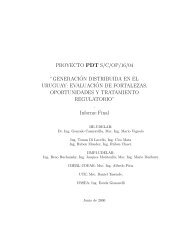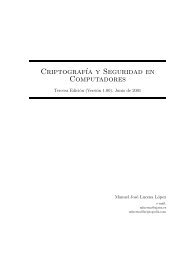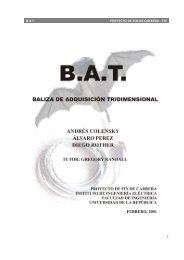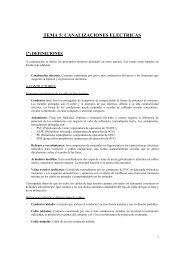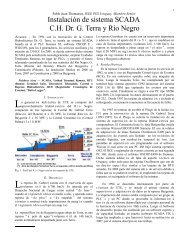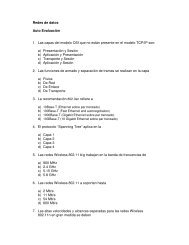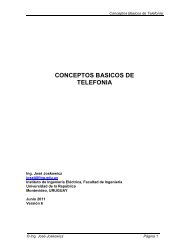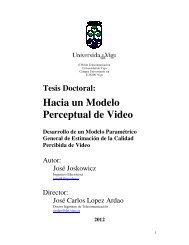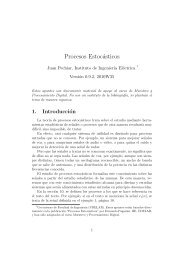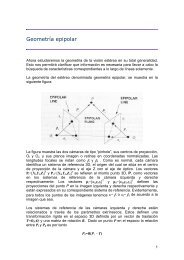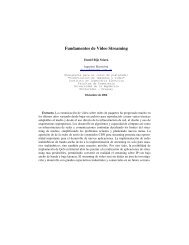of thermistor linearizing
of thermistor linearizing
of thermistor linearizing
Create successful ePaper yourself
Turn your PDF publications into a flip-book with our unique Google optimized e-Paper software.
Meas. Sci. Technol. 1 (1990) 1280-1284. Printed in the UK<br />
Error evaluation<br />
circuits<br />
<strong>of</strong> <strong>thermistor</strong> <strong>linearizing</strong><br />
Daniel Slomovitz and José Joskowicz<br />
UTE Laboratory, Paraguay 2385, Montevideo, Uruguay<br />
Received 25 January 1990, in final form 9July 1990, Accepted for publication<br />
8 August 1990<br />
Abslract. A simple designing method for <strong>linearizing</strong> circuits, based on one resistor,<br />
is presented. The errors caused by this circuit are calculated, considering the<br />
temperature range and the <strong>thermistor</strong> parameters. These errors are used as a<br />
basis for comparing the quality <strong>of</strong> active <strong>linearizing</strong> circuits. ln many cases,<br />
complex circuits recently proposed have similar errors to single resistor <strong>linearizing</strong><br />
circuits.<br />
It is shown that the exponential approximation is one <strong>of</strong> the most important error<br />
sources. We propose to use more precise models. The relationship between the<br />
parameters <strong>of</strong> the exponential model and those <strong>of</strong> other models is discussed.<br />
1, lntroduction<br />
A great number <strong>of</strong> <strong>thermistor</strong> <strong>linearizing</strong> circuits have<br />
been proposed. Some <strong>of</strong> them are based on resistors,<br />
while others use active components such as voltage to<br />
frequency converters, multipliers, etc.<br />
Hoge (1979) has shown that all circuits based on<br />
resistors (serial, parallel, bridge, etc) have the same<br />
capacity for <strong>linearizing</strong> the <strong>thermistor</strong> characteristic. On<br />
the other hand, proposers <strong>of</strong>active circuits generally present<br />
their errors associated with an experimental case.<br />
The comparison between different circuits is therefore<br />
difficult. Many papers lay claim to very accurate theoretical<br />
results. However, the experiments show large errors.<br />
All the authors have used the simplest, exponential <strong>thermistor</strong><br />
model in their theoretical studies. This model<br />
gives errors greater than expected for their circuits. For<br />
this reason we will analyse the behaviour <strong>of</strong> better <strong>thermistor</strong><br />
models.<br />
In section 3 we will calculate the lowest errors produced<br />
by resistor <strong>linearizing</strong> circuits. These values are<br />
going to be used as a basis for comparison with more<br />
complex circuits.<br />
2. Models <strong>of</strong> thermislors<br />
Equation (1) represents the well known exponential<br />
model<br />
R,: At exp (BtlT) (1)<br />
where R, is the <strong>thermistor</strong> resistance and T is the absolute<br />
temperature. ,4, is a parameter that depends on the<br />
material and geometry <strong>of</strong> the <strong>thermistor</strong>, while parameter<br />
Br depends on the material only. The At and Br values<br />
should be selected to obtain the best fit between the<br />
model and actual behaviour. In a temperature range <strong>of</strong><br />
-10"C to 100"C the error is about 1K (Slomovitz<br />
1987). Figure 1 (curve a) shows a typical error curve. The<br />
values are greater than those expected in active circuits.<br />
For this reason, it is not possible to calculate circuit<br />
errors in a theoretical analysis using the exponential<br />
model.<br />
Many models with lower errors than the exponential<br />
have been proposed. All <strong>of</strong> them have three parameters<br />
instead <strong>of</strong> two. This allows better adjustment. Equation<br />
(2) shows one <strong>of</strong> the best models, proposed by Steinhart<br />
and Hart (1968, to be referred to as sri).<br />
where<br />
R, : exp {+t(- F, + F )tt3 - (F, + Fr)t/tl} (2)<br />
F,:T@* llDlv<br />
F, : 1 ú{27 1@ - r l r)lyl', + 4(p lú3}t t2<br />
a, B and y being the three parameters <strong>of</strong> this model.<br />
Unfortunately, from a mathematical point <strong>of</strong> view it is<br />
Temp.<br />
Error<br />
(K)<br />
T<br />
(oc)<br />
Figure 1. Temperature error in <strong>thermistor</strong> models:<br />
a, exponential model; b, ees model.<br />
0957-02331901121280+05 $03.50 @ 1990 IOP Publishing Ltd
Thermistor <strong>linearizing</strong> circuits<br />
very cumbersome. Bosson et al (1950, to be referred to<br />
as ncs) have proposed another model with similar errors<br />
to the sn model for the temperature range - 10 "C to<br />
100 "C. When a large range is used (-60 "C to 150'C)<br />
the error <strong>of</strong> the scs model is three times greater than the<br />
sH one. However, we prefer to use the ncs model, because<br />
the mathematical expression (equation (3)) is simpler<br />
than sH. This is an important advantage in theoretical<br />
studies.<br />
R,: Az exp lBrl(T + 0)1. (3)<br />
The Ar, 82 and 0 parameters must be selected so as to<br />
fit the experimental Rt(T) curve as well as possible. A<br />
comparison <strong>of</strong> the error produced by these models in 13<br />
different <strong>thermistor</strong>s has been shown by Slomovitz<br />
(1987). The scs model produces errors 10 to 20 times<br />
smaller than the exponential model. A typical error curve<br />
is shown in figure 1 (curve b).<br />
The complexity <strong>of</strong> a theoretical study is increased<br />
when a three-parameter model is used. Nevertheless, the<br />
BGS parameters are not totally independent. A strong<br />
correlation between B, and I was observed when these<br />
parameters were calculated for the 13 <strong>thermistor</strong>s previously<br />
mentioned. Figure 2 shows that this relationship<br />
can be approximated by a straight line. The best straight<br />
line is<br />
0:0.017982- 42.7 (4)<br />
where 0 and B, are expressed in K. The standard deviation<br />
is 12%. This reduces the number <strong>of</strong> independent<br />
variables to two. Thus, studies using this model will not<br />
be more complicated than those using the exponential<br />
model.<br />
The parameter B, <strong>of</strong> the exponential model is related<br />
to the parameter 82 <strong>of</strong> the scs model. Figure 3 shows<br />
that when B, increases, B, also increases linearly. The<br />
points in this figure were calculated using data from the<br />
13 previously mentioned <strong>thermistor</strong>s. The best straight<br />
line for these points is given by using<br />
Bz:23328r- 3268. (5)<br />
Figure 3. Relationship between the parameters 8, (ecs<br />
model) and 8, (exponential model).<br />
In this way, it is possible to estimate the values <strong>of</strong> B, and<br />
0 from the value <strong>of</strong> Br. using equations (4) and (5). We<br />
will make use <strong>of</strong> this in section 4.<br />
3. Single resistor <strong>linearizing</strong> circuit<br />
Figure 4 shows one <strong>of</strong> the simplest <strong>linearizing</strong> circuits. U<br />
is a constant voltage, Z" the output voltage, R, is the<br />
<strong>thermistor</strong> and R is a resistor.<br />
4: u l{:(AzlR)exp lB'lQ + 0)l + U. (6)<br />
Figure 5 shows the relationship between V" and T.<br />
We define the relative-temperature error E, as the percentage<br />
temperature difference between the curve and the<br />
straight line (100 x (segment GH/Q). Q is given in kelvin.<br />
It is necessary, in the temperature range considered,<br />
to choose the value <strong>of</strong> R, and to select the straight line<br />
that fits the curve best, to reduce errors to a minimum.<br />
Boél e/ al (1965) have proposed choosing the tangent<br />
to the curve at the inflection point (corresponding to ft,),<br />
as the straight line. This should produce errors similar<br />
to those shown in figure 6, curve a. The value Q, is<br />
imposed in the middle <strong>of</strong> the temperature range by Boél<br />
82(K)<br />
Figure 2. Relationship between the BGS parameters 0<br />
and 8".<br />
Figure 4. Resistive <strong>linearizing</strong> circuit <strong>of</strong> <strong>thermistor</strong>s:<br />
U, constant voltage; l/", output voltage.<br />
1281
D Slomovitz and J Joskowicz<br />
Tg To<br />
Figure 5. Typical curve <strong>of</strong> output voltage V. versus the<br />
<strong>thermistor</strong> temperature. Io is ihe temperature<br />
corresponding to the inflection point.<br />
Figure 6, Temperature errors according to different<br />
designing methods: a, straight line tangent in the inflection<br />
point; b, straight line passing through the extremes points;<br />
c, straight line passing through Io with a slope between<br />
cases a and b.<br />
et al.This leads to a condition for the value <strong>of</strong> R. Using<br />
the scs model, this condition is<br />
Rr: Az exp lBrl(To + 0))<br />
x lBz- 2(To+ e)lllBr+ 2(To+ 0)f (7)<br />
Where Rr is the value <strong>of</strong> R calculated by this method.<br />
Beakley (1951) proposed using the straight line that<br />
passes through the two extreme points <strong>of</strong> the curve. The<br />
shape <strong>of</strong>the curve should be <strong>of</strong>the type shown in figure 6,<br />
curve b. He proposed choosing the R value according to<br />
(7)<br />
Khan (1985) mentioned that smaller errors could be<br />
obtained using a straight line that passes through the<br />
inflection point, with a slope slightiy smaller than the<br />
tangent. The shape <strong>of</strong> the error curve should be similar<br />
to curve c in figure 6. However, he did not show how to<br />
choose this slope.<br />
In all these cases, it was a condition that the inflection<br />
point <strong>of</strong> the curve was in the centre <strong>of</strong> the temperature<br />
range, and that the straight line passed through it. However,<br />
there is no theoretical reason to support this. We<br />
will show later that other criteria lead to smaller errors.<br />
The analytical determination <strong>of</strong> the R value and the<br />
best straight line for an optimal linearization is very cumbersome.<br />
These parameters depend on Ar, Br, 0 and the<br />
temperature range. We use a numerical method to solve<br />
this problem. The maximum value <strong>of</strong> E. was used as the<br />
quality parameter. However, in the other papers the<br />
absolute temperature difference E, (segment GH in<br />
figure 5) is used as the temperature error. For comparison<br />
with these other papers, our results are expressed as<br />
E,, in kelvin.<br />
It was supposed that equation (3) represented exactly<br />
the <strong>thermistor</strong> behaviour. The temperature difference h<br />
(h: [,"*i^u- - 4n,n,-u-) <strong>of</strong> the considered range, was<br />
varied between 50 K and 200 K. The <strong>thermistor</strong> parameters<br />
were varied in the following ranges: Bt between<br />
3000 K and 8000 K, and 0 +20% around the value given<br />
by equation (4). R is proportional to the parameter Ar,<br />
so it is not necessary to take into account the variation<br />
<strong>of</strong> Ar. A change in the value <strong>of</strong> A, only produces a<br />
proportional change in the value <strong>of</strong> R.<br />
The circuit analysed has three variables. They are R,<br />
and the two parameters that define the straight line. For<br />
these two parameters, we used two <strong>of</strong> the intersection<br />
points between the curve and the straight line (E and F<br />
in figure 5). The calculating program varies these three<br />
variabies, and selects the best values. This method usually<br />
uses a lot <strong>of</strong> computer time, but in this case we know<br />
approximately where the solution is. The two intersection<br />
points are near the extremes <strong>of</strong> the temperature<br />
interval and the value <strong>of</strong> R has the same order as the<br />
value given by equation (7).<br />
The error E, depends on the temperature difference<br />
h, but it does not depend on where the range is. Figure 7<br />
shows that different ranges lead to similar errors if h is<br />
constant. In this figure, the abscissa represents the central<br />
temperature f"(.7": (7."- + T^,^)12), and the ordinate the<br />
calculated error E,. The circles correspond to a <strong>thermistor</strong><br />
for which Br:3000 K, the crosses to Bt:5000 K<br />
and the triangles I"o 82:8000 K. In all these cases, the<br />
value <strong>of</strong> I has been calculated according to equation (4).<br />
The variation <strong>of</strong> 0 in a range <strong>of</strong> -12006 from the<br />
central value given by (4), does not alter the errors in<br />
practice. Figure 8 shows the variation <strong>of</strong> the error E,<br />
against the ratio 0100, 0o being the value given by<br />
equation (4). Thermistors with three different values <strong>of</strong><br />
Figure 7. lnfluence <strong>of</strong> the central temperature f on the<br />
error E,. The temperature difference h is 150 K for all the<br />
points. Circles, Ar:3000 K; crosses, 8r: 5000 K; triangles,<br />
Az: 8000 K. The value <strong>of</strong> 0 is given by equation (4).<br />
1282
Thermistor <strong>linearizing</strong> circuits<br />
4. Error comparison with proposed <strong>linearizing</strong> circuits<br />
Figure 8. lnfluence ot 0l0o on the error fi, 0o being the<br />
calculated value according to equation (4).<br />
1<br />
Brwere used (circles, Bz : 3000 K; crosses, Br : 5000 K;<br />
triangles, Bz : 8000 K). E, varies less than 14oA tn all<br />
these cases. The temperature range was 0'C to 100'C<br />
for all the points.<br />
Accordingly, errors corresponding to different<br />
methods are shown only as a function <strong>of</strong> h and 82. All<br />
the temperature ranges begin at 0'C.<br />
A large number <strong>of</strong> cases were studied using the<br />
numerical method. From the results, a simple heuristic<br />
designing method is proposed. This new method is very<br />
simple to use. We suggest choosing the value <strong>of</strong> R according<br />
to the heuristic equation<br />
R: kRf (8)<br />
where /r : 0.00313h + 0.913. k varies between 1.07 for h:<br />
50K and 1.54 for h:200 K. As the straight line, we<br />
propose choosing one that produces null errors at temperatures<br />
correspondingto 6.90/o and 89.5oh <strong>of</strong> h. As an<br />
example, consider a - 10 'C to 80 "C range. The value<br />
<strong>of</strong> h is 90 K. There should be null errors at - 3.8 'C<br />
(- 10 + 0.069 x 90) and 70.6 "C (- 10 + 0.895 x 90).<br />
A comparison between the three methods mentioned<br />
is presented in table 1. The proposed method (column 6)<br />
has errors which are three times smaller than the Boél<br />
method shown in column 4, and 1.6 times lower than the<br />
Beakley method shown in column 5. On the other hand,<br />
the average error <strong>of</strong> the proposed method is only 1.09<br />
times greater than the errors generated by the numerical<br />
method (column 7).<br />
All authors, at present, have used the exponential <strong>thermistor</strong><br />
model in their analyses. To compare their results<br />
against the proposed circuit. it is necessary to estimate<br />
B, and 0 from the value Br. For this purpose, we will<br />
use equations (4) and (5).<br />
Sundqvist (1983) proposed a voltage to frequency<br />
converter. According to his theoretical analysis, based on<br />
the exponential model, the error should be zero. Nevertheless,<br />
in his experimental results, errors as large as 2 K<br />
appear in a 100 K range. These errors are attributed to<br />
model errors. The <strong>thermistor</strong> used had Bt: 3725 K. This<br />
is approximately equivalent to Bz:5420K. From<br />
table 1 it is concluded that the error <strong>of</strong>a resistive <strong>linearizing</strong><br />
circuit should be around 3.6 K. This error is <strong>of</strong> a<br />
similar order to the active circuit error. This confirms<br />
that the exponential model must not be used with active<br />
circuits. Otherwise, the errors should be smaller than<br />
those produced by resistive <strong>linearizing</strong> circuits.<br />
Patranabis et al (1988) proposed using an active circuit<br />
based on a logarithmic amplifier. They showed<br />
errors around 1 K in the range 30'C to 95 'C. (They did<br />
not show the <strong>thermistor</strong> value <strong>of</strong> Bt.) Using a resistive<br />
circuit the error should be between 1 K and 2 K,<br />
depending on the <strong>thermistor</strong> (see table 1). This shows<br />
that just a single resistor is equivalent to a complex circuit,<br />
so the usefulness <strong>of</strong> the circuit is doubtful.<br />
Sengupta (1988) proposed a temperature to frequency<br />
converter. His experimental results show errors <strong>of</strong> 0.7 K<br />
in a range <strong>of</strong> 5'C to 85 "C. The <strong>thermistor</strong> used had<br />
Br : 3400 K, corresponding to 82:4600 K. Table 1<br />
shows that a resistive circuit has errors <strong>of</strong> around 2 K<br />
for the same conditions. For applications where this<br />
slightly higher error is acceptable, the resistive circuit<br />
<strong>of</strong>fers a much more cost-effective solution than the active<br />
circuit.<br />
On the other hand, Cole (1957)used a resistive circuit.<br />
During the experimental work, he empirically adjusted<br />
the resistor values and the straight line to obtain the<br />
smallest error. The range considered was 2"C to 48 "C.<br />
He imposed null errors at 5'C and 45 "C. These values<br />
Table 1.<br />
82 Range<br />
(K) (K)<br />
h<br />
(K)<br />
Method 1 Method 2 Method 3<br />
E (K) E (K) E (K)<br />
(Boél) (Beakley) (proposed)<br />
Numerical<br />
method<br />
E. (K)<br />
3000<br />
3000<br />
3000<br />
3000<br />
273-323<br />
273-373<br />
273-423<br />
273-473<br />
50<br />
100<br />
150<br />
200<br />
1.3<br />
7.5<br />
17.8<br />
29.2<br />
0.6<br />
4.2<br />
10.6<br />
15.4<br />
0.4<br />
2.5<br />
6.3<br />
12.3<br />
0.3<br />
2.3<br />
5.9<br />
9.9<br />
5000<br />
5000<br />
5000<br />
5000<br />
273-323<br />
273-373<br />
273-423<br />
273-473<br />
50<br />
100<br />
150<br />
200<br />
2.2<br />
11.9<br />
28.8<br />
51.6<br />
1.0<br />
o.ó<br />
15.7<br />
26.8<br />
0.6<br />
3.6<br />
9.3<br />
17.5<br />
0.6<br />
3.6<br />
8.5<br />
16.1<br />
8000<br />
8000<br />
8000<br />
8000<br />
273-323<br />
273-373<br />
273-423<br />
273-473<br />
50<br />
100<br />
150<br />
200<br />
3.0<br />
16.4<br />
38.9<br />
68.1<br />
1.4<br />
8.2<br />
20.3<br />
35.4<br />
0.9<br />
4.8<br />
12.2<br />
22.7<br />
0.9<br />
4.8<br />
11.0<br />
20.8<br />
1 283
D Slomovitz and J Joskowicz<br />
are very close to those recommended for the proposed<br />
method (5 "C and 43'C). The <strong>thermistor</strong> used had Bt :<br />
3463 K, corresponding to 82 : 4800 K. The error<br />
obtained, -E,, by Cole was 0.7 K. Table 1 forecasts 0.6 K.<br />
This shows that the theoretical errors shown in table 1,<br />
column 6, can be obtained in real experiments.<br />
5. Conclusions<br />
A method for designing resistive <strong>linearizing</strong> circuits has<br />
been proposed. It is based on a three-parumeter <strong>thermistor</strong><br />
model (Bosson et aI 1950). Analysis <strong>of</strong> this model<br />
shows that there is a strong correlation between the parameters.<br />
Also, simple equations relate these parameters<br />
to the exponential model parameters.<br />
An error comparison between the proposed method<br />
and active circuits was done. It is surprising that a lot <strong>of</strong><br />
recent papers show errors <strong>of</strong> the same order as those<br />
produced by single resistor circuits. The principal cause<br />
is that all <strong>of</strong> them are based on the simple exponential<br />
approximation. For this reason they cannot be expected<br />
to be perfect.<br />
We propose using the results <strong>of</strong> this paper as a basis<br />
for comparison <strong>of</strong> the quality <strong>of</strong> active <strong>linearizing</strong><br />
circuits.<br />
References<br />
Beakley W R 1951 The design <strong>of</strong> <strong>thermistor</strong> thermometers<br />
with linear calibration J. Sci. Instrum.2S 176-9<br />
Boé1 M and Erickson B 1965 Correlation study <strong>of</strong> a<br />
<strong>thermistor</strong> thermometer Reu. Scí. Instrum. 36 904-8<br />
Bosson G, Gutmann F and Simmons L M 1950 A<br />
relationship between resistance and temperature <strong>of</strong><br />
<strong>thermistor</strong>s J. Appl. Phys.21 1267-8<br />
Cole K S 1957 Thermistor thermometer bridge: linearity and<br />
sensitivity for a range <strong>of</strong> temperature Reu. Sci. InsÚum.<br />
28 326-8<br />
Hoge H J 1979 Comparison <strong>of</strong> circuits for <strong>linearizing</strong> the<br />
temperature indications <strong>of</strong> <strong>thermistor</strong>s Reu. Sci. Instrum.<br />
s0 316-20<br />
Khan A A 1985 Linearization <strong>of</strong> <strong>thermistor</strong> thermometer Inú.<br />
J. Electron.59 129 39<br />
Patranabis D, Ghosh S and Bakshi C 1988 Linearizing<br />
transducer characteristics IEEE Trans. Instrum. Meas.37<br />
66-9<br />
Sengupta R N 1988 A widely linear temperature to frequency<br />
converter using a <strong>thermistor</strong> in a pulse generator IEEE<br />
Trans. Instum. Meas.37 62-5<br />
Slomovitz D 1987 The temperature/resistance curve <strong>of</strong> NTC<br />
<strong>thermistor</strong>s Test and Measurement World 7 (5) 73-9<br />
Steinhart J S and Hart S R 1968 Calibration curves for<br />
<strong>thermistor</strong>s Deep-Sea Res. 15 497-503<br />
Sundqvist B 1983 Simple, wide-range, linear temperature-t<strong>of</strong>requency<br />
conve¡ters using standard <strong>thermistor</strong>s J. Phys.<br />
E: Sci. Instrum. 16 261-4<br />
1284


